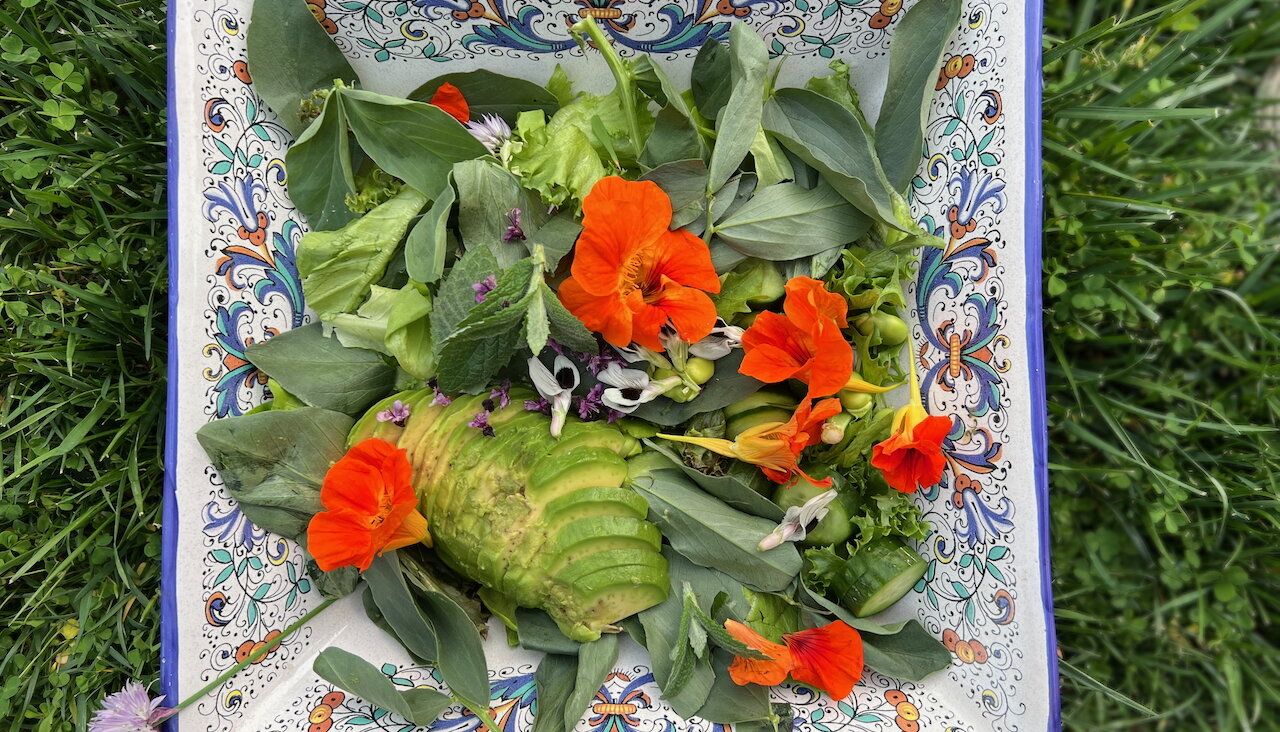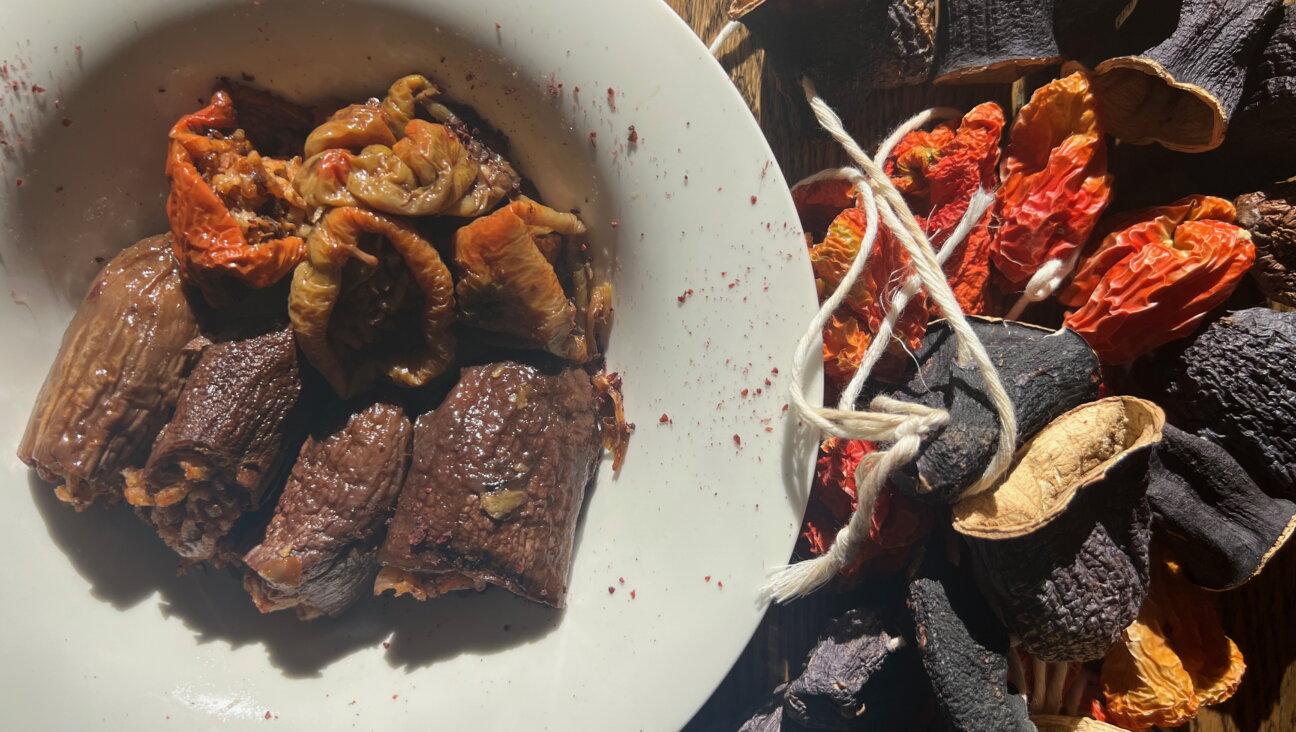Looking Back — and Forward — to Schav

Photo: Joelle Abramowitz
Sometimes we need to encounter something new to help us unearth a remnant from the past.
“This week, I got sorrel,” I told my mother. Each week I’d recite to my mother what had come in my CSA share and what I ended up doing with my vegetables. The sorrel was notable because somehow, on my third year of being a CSA member, I still had not yet encountered sorrel for myself.
After receiving my box of vegetables, I tasted a small piece of the sorrel. It was as I’d expected, but more: lemony and sour and wonderful. Having only a few ounces of sorrel, I decided to make a sorrel-onion tart. Indeed, the bites with ample sorrel were quite lovely and refreshing.
I related my sorrel adventure to my mother.
“You know,” my mother chimed in, “Bubbe used to make a green soup. I think it was probably with sorrel. I think it’s called schav. You should look it up on the Internet: S-C-H-A-V.”
“OK, mom, I’ll look it up.”
“I never tried it, because it was weird-looking.” Now this was a surprise. Bubbe was my mother’s grandmother, who passed away before I was born. Mostly what I learned of Bubbe related to her culinary prowess involving old world dishes: blintzes, rugelach, cow lung (my mother stopped eating it when she found out what it was), to name a few. Whenever my mother would describe Bubbe’s cooking, she would also express her regret in not having Bubbe’s recipes, that no matter what recipes she finds, they’re not quite the same. But since my mother had never tried the schav, I didn’t even know where to begin.
So I began searching around, as my mother insisted, and started with some trusted sources. First up was The New York Times. In their recipe, sorrel and potatoes, amongst other soup ingredients, are cooked together and then blended into a creamy puree. Next, I made my way to My Jewish Learning and came across a very different concoction. In their recipe, the sorrel leaves and a bundle of its ribs and stems and set to steep in a pot of water. After discarding the rib and stem bundle, beaten eggs are incorporated into the broth. While I understood that both recipes did indeed fit the description of “sorrel soup,” they seemed so different. I wanted to know, which was the authentic version? Would the real schav please stand up?
Knowing all the diversity in Jewish geography and culinary tastes, I shouldn’t have been all that surprised that there was no master schav recipe. I described the two recipes to my mother to see if she could provide any insight into what bubbe’s schav was like despite her never having tasted it.
“I think there was a potato involved.” So that was somewhat helpful, but it still didn’t fully resolve the discrepancies in the recipes I’d found.
Already overwhelmed by the two options I’d discovered, I gave up on Internet-searching for schav, and decided to turn to the resource I should have consulted in the first place: Gil Marks’ Olive Trees and Honey. There, I learned the background on schav in a more digestible (ahem) way. I learned that schav is the Slavic term for sorrel, that it grows wild in Eastern Europe in the spring, that the variation with eggs was an indulgence for the wealthy. Their recipe included elements of each of the two I’d found: sorrel and potatoes are cooked together (and can be pureed, or not) and adding egg yolks at the end is optional.
By the time I’d finished reading, I’d become really excited about schav. But then I grew sad when I remembered that I had already used up my sorrel in my tart that was indeed tasty, but was lacking in cultural significance. I found comfort in reminding myself the small amount of sorrel I’d had would not have been enough for even a quarter of the schav recipe.
So now I wait for an abundance of sorrel to come again. I plan to make the Olive Trees and Honey recipe and add eggs to some of the soup while keeping the rest plain to hold my own personal schav smackdown. I know that it likely won’t taste the same as Bubbe’s. Really, though, there’s no one to tell me whether it does or doesn’t, and I’m not sure whether that makes me feel better or worse. But maybe it doesn’t matter if the schav I make is the same schav that Bubbe made. Maybe what matters is to make the schav and to think of her and honor my mother’s memory of her.
Suffice it to say, I can’t hardly wait to make my first schav.
Joelle is an economist and writes about food and life in Washington, DC.
Photo Credit: Joelle Berman
The Forward is free to read, but it isn’t free to produce

I hope you appreciated this article. Before you go, I’d like to ask you to please support the Forward.
Now more than ever, American Jews need independent news they can trust, with reporting driven by truth, not ideology. We serve you, not any ideological agenda.
At a time when other newsrooms are closing or cutting back, the Forward has removed its paywall and invested additional resources to report on the ground from Israel and around the U.S. on the impact of the war, rising antisemitism and polarized discourse.
This is a great time to support independent Jewish journalism you rely on. Make a gift today!
— Rachel Fishman Feddersen, Publisher and CEO
Support our mission to tell the Jewish story fully and fairly.
Most Popular
- 1

Fast Forward Ye debuts ‘Heil Hitler’ music video that includes a sample of a Hitler speech
- 2

Opinion It looks like Israel totally underestimated Trump
- 3

Culture Is Pope Leo Jewish? Ask his distant cousins — like me
- 4

Fast Forward Student suspended for ‘F— the Jews’ video defends himself on antisemitic podcast
In Case You Missed It
-

Fast Forward For the first time since Henry VIII created the role, a Jew will helm Hebrew studies at Cambridge
-

Fast Forward Argentine Supreme Court discovers over 80 boxes of forgotten Nazi documents
-

News In Edan Alexander’s hometown in New Jersey, months of fear and anguish give way to joy and relief
-

Fast Forward What’s next for suspended student who posted ‘F— the Jews’ video? An alt-right media tour
-
Shop the Forward Store
100% of profits support our journalism
Republish This Story
Please read before republishing
We’re happy to make this story available to republish for free, unless it originated with JTA, Haaretz or another publication (as indicated on the article) and as long as you follow our guidelines.
You must comply with the following:
- Credit the Forward
- Retain our pixel
- Preserve our canonical link in Google search
- Add a noindex tag in Google search
See our full guidelines for more information, and this guide for detail about canonical URLs.
To republish, copy the HTML by clicking on the yellow button to the right; it includes our tracking pixel, all paragraph styles and hyperlinks, the author byline and credit to the Forward. It does not include images; to avoid copyright violations, you must add them manually, following our guidelines. Please email us at [email protected], subject line “republish,” with any questions or to let us know what stories you’re picking up.















